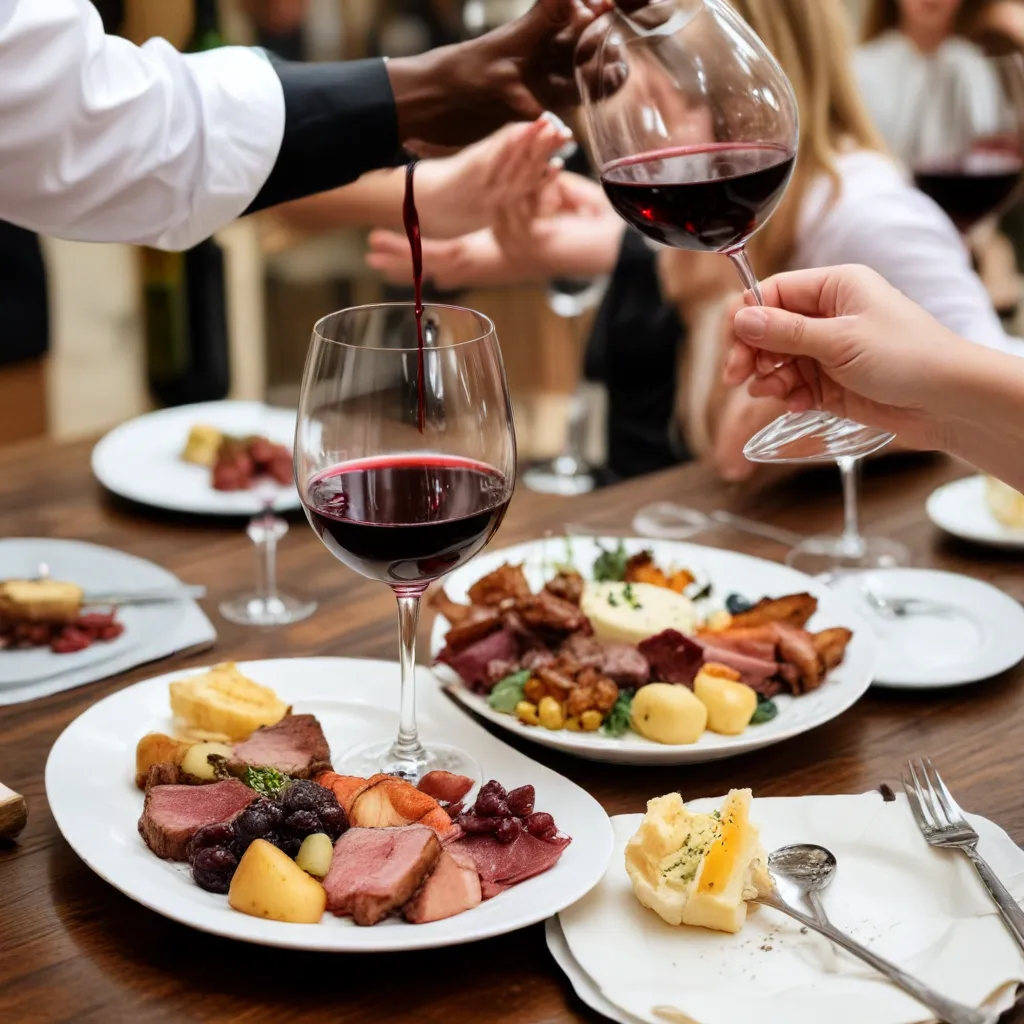
The world of food and wine pairing is a symphony of flavors, textures, and emotions. It’s a dance where the perfect partners accentuate each other’s strengths, creating a harmonious and elevated dining experience. As a hospitality and wine expert at the Wine Garden Inn, I’m excited to guide you through the art of food-wine matchmaking, unveiling the secrets to crafting those mouthwatering, unforgettable pairings.
The Fundamentals of Food-Wine Matchmaking
At the heart of every successful pairing lies a deep understanding of flavor profiles and compatibility. The key is to identify the dominant tastes in both the food and wine, and then find complementary or contrasting elements that bring out the best in each.
Flavor Profiles and Compatibility
Beginning with the food, we must consider the primary flavors – whether it’s savory, sweet, sour, bitter, or umami. These foundational tastes serve as the guiding principles for pairing. For example, a rich, creamy dish like Beef Bourguignon pairs beautifully with a bold, full-bodied Cabernet Sauvignon, as the wine’s intense fruit and tannins can stand up to the robust flavors of the stew.
Balancing Acidity and Tannins
On the wine side, understanding the role of acidity and tannins is crucial. Acidity in wine can help cut through the richness of fatty foods, while tannins provide a counterbalance to spicy or heavily seasoned dishes. A vibrant, high-acid Sauvignon Blanc, for instance, can refresh the palate and complement the heat of a Thai curry.
Considering Texture and Mouthfeel
But the pairing journey doesn’t stop there. The texture and mouthfeel of both the food and wine must also be taken into account. A delicate, flaky fish pairs beautifully with a light, crisp Pinot Grigio, whereas a hearty, slow-braised lamb shank calls for the velvety, full-bodied presence of a Syrah.
Pairing Strategies for Different Cuisines
As we venture beyond the basics, the art of food-wine pairing becomes ever more fascinating. Each culinary tradition brings its own unique flavor profiles and cooking techniques, requiring a nuanced approach to find the perfect pairings.
Traditional European Pairings
In the realm of classic European cuisine, the rules of pairing tend to be more well-established. A juicy, medium-rare steak is a natural match for a robust Bordeaux, while a creamy Risotto alla Milanese finds its soulmate in a fragrant, oakaged Chardonnay.
Exploring Asian and Latin American Flavors
Venturing into the realms of Asian and Latin American cuisines, the pairing game becomes more dynamic. The vibrant, often complex flavors of dishes like Pad Thai or Mole Poblano demand a more adventurous approach. A lively, off-dry Riesling can tame the heat of spicy Thai fare, while a fruit-forward Tempranillo can harmonize beautifully with the earthy, umami notes of Mexican mole.
Navigating Vegetarian and Vegan Options
As dietary preferences evolve, the world of food-wine pairing must adapt as well. Crafting pairings for vegetarian and vegan dishes requires a keen understanding of plant-based ingredients and their unique flavor profiles. A hearty, umami-rich Portobello Mushroom Risotto, for instance, finds a perfect match in a smooth, earthy Pinot Noir.
The Art of Complementary Flavors
Beyond the basics of matching flavor profiles, the true mastery of food-wine pairing lies in the ability to create harmonious, synergistic connections between the two.
Identifying Shared Ingredients
One effective strategy is to identify shared ingredients between the food and wine, and then amplify those flavors. For example, a dish featuring fresh, local tomatoes can be elevated by pairing it with a Sangiovese-based wine, which often exhibits bright, juicy tomato-like notes.
Harmonizing Dominant Tastes
Another approach is to harmonize the dominant tastes in both the food and wine. A rich, creamy Lobster Bisque, for instance, can be beautifully complemented by a lush, buttery Chardonnay, with both the food and wine showcasing sumptuous, indulgent flavors.
Contrasting Flavor Intensities
On the other hand, pairing can also thrive on strategic contrasts. A delicate, pan-seared Halibut fillet, for example, can be elevated by the bold, peppery punch of a Syrah, creating a delightful balance of power and elegance.
Enhancing the Dining Experience
Successful food-wine pairing goes beyond just flavor compatibility; it’s about creating an immersive, multisensory dining experience that engages all the senses.
The Role of Aroma and Appearance
The aroma and appearance of both the food and wine play a crucial role in setting the stage. A vibrant, aromatic Gewürztraminer can heighten the sensory experience of a fragrant Thai Coconut Curry, while the visual presentation of a dish can influence how we perceive and appreciate its accompanying wine.
Pairing with Mood and Occasion
Equally important is the consideration of mood and occasion. A casual backyard barbecue calls for a lively, easy-drinking Rosé, while a special anniversary dinner may warrant the elegance of a well-aged Bordeaux. The pairing should enhance the overall atmosphere and make the dining experience truly memorable.
Creativity in Experimentation
Finally, the world of food-wine pairing is not set in stone. There’s always room for creativity and experimentation. Stepping out of our comfort zones and pairing unexpected combinations can lead to delightful discoveries and inspire us to think beyond the conventional.
As you embark on your own food-wine pairing journey, embrace the art of discovery, trust your senses, and don’t be afraid to explore. After all, the true beauty of this culinary dance lies in the joy of finding those perfect pairings that elevate both the food and wine, resulting in an unforgettable dining experience. Visit the Wine Garden Inn to explore our curated selection of gourmet breakfasts, estate-grown produce, and expertly crafted wine pairings that will transport you to the heart of the vineyards.
